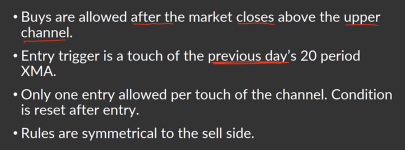Lone Wolf
New member
Hi,
Does anybody know if I can scan using TOS for stocks where the body of the candle is COMPLETELY above or below the upper/lower Keltner Channel (using length 20, and 2.25 ATR)?
I see there are criteria for Bollinger bands there, but I am looking to scan for stocks where the body is completely outside the Keltner channel.
Let me know.
Thanks!
Does anybody know if I can scan using TOS for stocks where the body of the candle is COMPLETELY above or below the upper/lower Keltner Channel (using length 20, and 2.25 ATR)?
I see there are criteria for Bollinger bands there, but I am looking to scan for stocks where the body is completely outside the Keltner channel.
Let me know.
Thanks!

